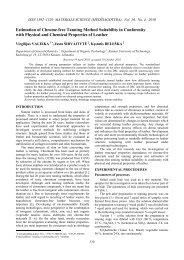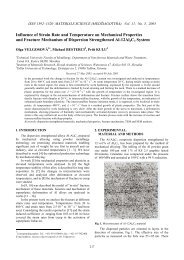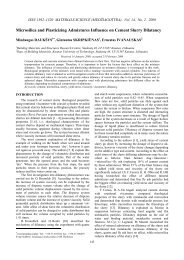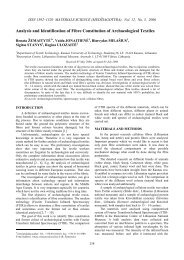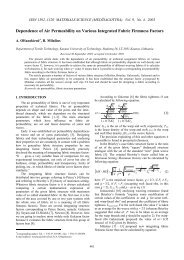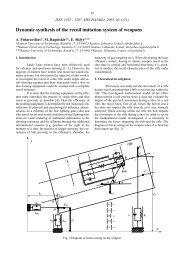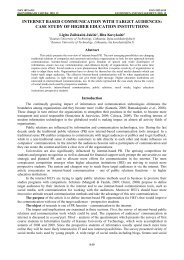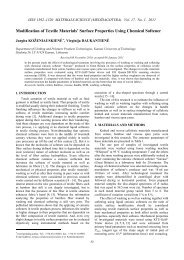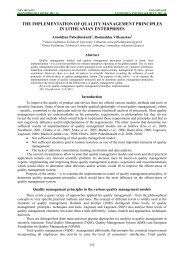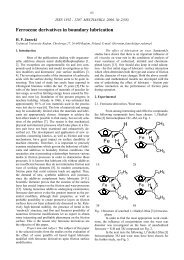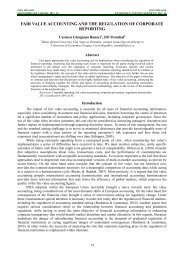Properties of Suspension and Pastes of Different Types of ... - KTU
Properties of Suspension and Pastes of Different Types of ... - KTU
Properties of Suspension and Pastes of Different Types of ... - KTU
You also want an ePaper? Increase the reach of your titles
YUMPU automatically turns print PDFs into web optimized ePapers that Google loves.
ISSN 1392–1320 MATERIALS SCIENCE (MEDŽIAGOTYRA). Vol. 13, No. 4. 2007<br />
<strong>Properties</strong> <strong>of</strong> <strong>Suspension</strong> <strong>and</strong> <strong>Pastes</strong> <strong>of</strong> <strong>Different</strong> <strong>Types</strong> <strong>of</strong> Microsilica<br />
with Various Deflocculants<br />
Ina PUNDIENĖ ∗ , Rimvydas STONYS, Stasys GOBERIS, Valentin ANTONOVIČ<br />
Institute <strong>of</strong> Thermal Insulation, Vilnius Gediminas Technical University, Linkmenų 28, LT-08217 Vilnius, Lithuania<br />
Received 05 September 2007; accepted 29 October 2007<br />
Microsilica is currently being used in a wide range <strong>of</strong> refractory castables <strong>and</strong> its quality influences performance,<br />
particularly flow <strong>and</strong> set <strong>of</strong> castables. In the present work, two different types <strong>of</strong> microsilica “Elkem ASA Materials”<br />
(grade 983U) <strong>and</strong> polish “Silimic” have been investigated. It was established that the differences between the<br />
characteristics <strong>of</strong> paste <strong>and</strong> suspensions <strong>of</strong> microsilica (pH, electric conductivity, viscosity) depend on the quality <strong>of</strong><br />
microsilica. The influence <strong>of</strong> type <strong>and</strong> amount <strong>of</strong> microsilica on the pH, electric conductivity <strong>and</strong> viscosity behavior <strong>of</strong><br />
alumina cement Gorkal-40 <strong>and</strong> microsilica pastes has been investigated in details. Deflocculants Castament FS-20 <strong>and</strong><br />
sodium tripolyphosphatum were used to control the characteristics <strong>of</strong> the investigated materials. The influence <strong>of</strong> their<br />
amount on the characteristics <strong>of</strong> various suspensions <strong>and</strong> pastes was estimated. It is shown that rheological characteristic<br />
<strong>of</strong> middle cement castable, which contains in its composition with microsilica <strong>of</strong> low quality, may be increased<br />
considerably if the right amount <strong>of</strong> the right deflocculant is added.<br />
Keywords: microsilica, deflocculants, pH, electric conductivity, viscosity, rheological properties.<br />
1. INTRODUCTION ∗<br />
Presently the traditional refractory castables are more<br />
<strong>and</strong> more <strong>of</strong>ten replaced by castables <strong>of</strong> new generation<br />
where microsilica <strong>of</strong> various types <strong>and</strong> <strong>of</strong> various content<br />
<strong>of</strong> impurities is used. For economical purposes, it is<br />
desirable to use the low-price microsilica in castables.<br />
However, the cheaper is microsilica, the greater amount <strong>of</strong><br />
impurities it contains. On the other h<strong>and</strong>, microsilica may<br />
affect rheological properties <strong>of</strong> castables [1 – 4]. The<br />
impurities present in microsilica as well as the basic<br />
physical properties can have a marked effect on castable<br />
properties via interactions with the hydration process. It is<br />
established that carbon <strong>and</strong> other impurities, such as Na2O,<br />
K2O, MgO, SO3 provoke creation <strong>of</strong> gels <strong>and</strong> flocculation,<br />
therefore reduce flow <strong>and</strong> rapid flow decay [5].<br />
In Lithuania, for lining <strong>of</strong> thermal equipments, the<br />
refractory castables with chamotte aggregates resistant to<br />
temperature <strong>of</strong> about 1300 °C are widely used. However,<br />
there are no studies specially designed for investigation <strong>of</strong><br />
rheology <strong>of</strong> castables containing chamotte components <strong>and</strong><br />
microsilica <strong>of</strong> different types.<br />
As may be seen from the references [6 – 7], addition <strong>of</strong><br />
a deflocculant is indispensable, since its nature <strong>and</strong><br />
properties influence the rheological properties <strong>of</strong> high<br />
temperature composition <strong>of</strong> the paste with microsilica. One<br />
<strong>of</strong> the most widespread deflocculants in the production <strong>of</strong><br />
castables is sodium tripolyphosphatum. Lately sodium<br />
polycarboxilate – Castament FS-20 is gaining popularity.<br />
The aim <strong>of</strong> the study is to investigate the influence <strong>of</strong><br />
deflocculants <strong>of</strong> two types on the properties <strong>of</strong> compositions<br />
with microsilica <strong>of</strong> different quality.<br />
2. EXPERIMENTAL<br />
The present study deals with two different types <strong>of</strong><br />
microsilica, namely microsilica 983U <strong>of</strong> mark (E), the<br />
∗ Corresponding author. Tel.: +370-5-2752231; fax.: +370-5-2731236.<br />
E-mail address: futer@centras.lt (I. Pundienė)<br />
317<br />
Norwegian firm ELKEM ASA MATERIALS, <strong>and</strong><br />
microsilica „Silimic“ (S) produced in Pol<strong>and</strong> (Huta<br />
Laziska). The chemical analysis (in mass %) <strong>and</strong> physical<br />
properties <strong>of</strong> which are presented in Table 1.<br />
Alumina cement "Gorkal-40" (C) is manufactured in<br />
Pol<strong>and</strong>. According to producer data the content <strong>of</strong> Al2O3 is<br />
not smaller than 40 percent. The main mineral phases are<br />
as following: CA, the ferrite phase, C12A7, C2AS; bulk<br />
density <strong>of</strong> 1160 kg/m 3 , specific surface <strong>of</strong> 300 m 2 /kg,<br />
refractories – not lower than 1280 °C.<br />
Chamotte aggregate is made crushing chamotte bricks,<br />
the density <strong>of</strong> which is 1920 kg/m 3 . (The amount <strong>of</strong> Al2O3<br />
is (30 – 33) %; water saturation (fr. 2.5 mm – 5 mm) –<br />
16.8 %; bulk density (fr. 2.5 mm – 5 mm) – 970 kg/m 3 ;<br />
crushing strength in a cylinder (fr. 2.5 – 5 mm) – 4.4 MPa.<br />
Dispersive chamotte is made grinding chamotte <strong>of</strong> the<br />
same type in a laboratory ball mill. Additionally it is sifted<br />
out using a separator the meshes <strong>of</strong> which are <strong>of</strong> 0.14 mm<br />
diameter. Dispersive chamotte <strong>of</strong> 75 % is made up <strong>of</strong><br />
Table 1. Chemical analysis <strong>and</strong> physical properties <strong>of</strong> microsilica <strong>of</strong> two types<br />
Type<br />
SiO 2,<br />
%<br />
Al 2O 3,<br />
%<br />
Fe 2O 3,<br />
%<br />
C,<br />
%<br />
CaO,<br />
%<br />
MgO,<br />
%<br />
318<br />
K 2O,<br />
%<br />
Na 2O,<br />
%<br />
SO 3,<br />
%<br />
pH<br />
LOI,<br />
%<br />
Bulk density,<br />
kg/m 3<br />
E 98.6 0.26 0.02 0.2 0.15 0.07 0.12 0.06 0.08 5.5 0.44 410<br />
S 90.6 1.2 1.5 2.83 0.5 1.5 0.63 0.68 2.0 330<br />
the content <strong>of</strong> deflocculant was also calculated in per cent<br />
<strong>of</strong> solids content.<br />
For investigations <strong>of</strong> viscosity <strong>of</strong> pastes, the vibroviscosimeter<br />
SV-10 was used. The solid-water ratio in pastes<br />
with microsilica was 0.9, while that in compositions <strong>of</strong><br />
cement <strong>and</strong> microsilica paste 0.7. For estimation <strong>of</strong><br />
rheological properties <strong>of</strong> the paste <strong>of</strong> refractory castable,<br />
the flow factor (ISO/DIS 13765-2) in % was determined.<br />
3. RESULTS AND DISCUSSION<br />
3.1. Experiments with suspensions <strong>and</strong> pastes<br />
The two-hour investigations <strong>of</strong> electrical conductivity<br />
in the suspensions <strong>of</strong> two-type pure microsilica E <strong>and</strong> S<br />
(Fig. 1) showed that the electrical conductivity in the<br />
suspension S increased by 2.4 times, due to much greater<br />
amount <strong>of</strong> impurities dissolved in the course <strong>of</strong> the<br />
investigation period, meanwhile in the suspension E the<br />
electric conductivity hardly changed. Respectively, pH<br />
shows that in the suspension with microsilica S the alkaline<br />
medium formed, while in that with microsilica E the<br />
neutral one.<br />
Conductivity, μS/cm<br />
2000<br />
1500<br />
1000<br />
500<br />
0<br />
E S pH(E) pH(S)<br />
0 15 30 45 75 120<br />
Time, min<br />
9<br />
8.5<br />
8<br />
7.5<br />
7<br />
6.5<br />
6<br />
Fig. 1. Changes <strong>of</strong> pH <strong>and</strong> electrical conductivity in the suspensions<br />
with microsilica E <strong>and</strong> S within two-hour period<br />
It is important to determine the influence <strong>of</strong> deflocculants<br />
addition in solution. The solutions <strong>of</strong> deflocculants<br />
were made by dissolving 0.1 g <strong>of</strong> deflocculant in 100 g <strong>of</strong><br />
water. The indices <strong>of</strong> pH <strong>and</strong> electrical conductivity <strong>of</strong><br />
pure solutions <strong>of</strong> deflocculants are presented in Table 2.<br />
Table 2. Electrical conductivity <strong>and</strong> pH <strong>of</strong> solutions <strong>of</strong><br />
deflocculants<br />
Name<br />
<strong>of</strong> deflocculant<br />
pH<br />
Electrical conductivity,<br />
μS/cm<br />
NT 8.54 900<br />
FS-20 4.35 250<br />
The influence <strong>of</strong> content <strong>of</strong> deflocculant on pH <strong>and</strong><br />
electrical conductivity in the suspensions E <strong>and</strong> S was<br />
investigated (Figs. 2 <strong>and</strong> 3).<br />
pH<br />
Conductivity, μS/cm<br />
1200<br />
1000<br />
800<br />
600<br />
400<br />
200<br />
0<br />
E+FS20 E+NT<br />
pH(E+FS-20) pH(E+NT)<br />
0 0.05 0.1 0.15 0.2 0.25 0.5 1<br />
Amount <strong>of</strong> deflocculant, %<br />
pH<br />
8.5<br />
Fig. 2. Changes <strong>of</strong> pH <strong>and</strong> electrical conductivity in the<br />
microsilica suspension E subject to the amount <strong>of</strong> added<br />
deflocculant NT <strong>and</strong> FS-20<br />
The added deflocculant NT, in comparison to that <strong>of</strong><br />
FS-20, increases considerably the indices <strong>of</strong> pH <strong>and</strong><br />
electrical conductivity <strong>of</strong> suspension <strong>of</strong> microsilica E. The<br />
deflocculant FS-20 increases the values <strong>of</strong> electrical<br />
conductivity much slower, but it highly reduces the pH<br />
values.<br />
Conductivity, μS/cm<br />
2500<br />
2000<br />
1500<br />
1000<br />
500<br />
0<br />
S+FS-20 S+NT<br />
pH(S+F-20) pH(S+N)<br />
0 0.05 0.1 0.15 0.2 0.25 0.5 1<br />
Amount <strong>of</strong> deflocculant, %<br />
8<br />
7.5<br />
7<br />
6.5<br />
6<br />
5.5<br />
5<br />
4.5<br />
4<br />
9 pH<br />
Fig. 3. Changes <strong>of</strong> pH <strong>and</strong> electrical conductivity in the<br />
suspension <strong>of</strong> microsilica S subject to the amount <strong>of</strong><br />
added deflocculant NT <strong>and</strong> FS-20<br />
In the suspension S the effect <strong>of</strong> deflocculants shows<br />
up in the similar way as in the suspension E, however, in<br />
the former case the indices <strong>of</strong> electrical conductivity <strong>and</strong><br />
pH are much higher, since the impurities contained in<br />
microsilica dissolve in water. When the amount <strong>of</strong> deflocculant<br />
FS-20 added to the suspension <strong>of</strong> microsilica E<br />
reaches 1 %, then pH decreases down to 4.5, while pH <strong>of</strong><br />
suspension <strong>of</strong> microsilica S is 6.5. The effect <strong>of</strong> deflocullant<br />
NT on pH changes in both suspensions is much poorer<br />
than that <strong>of</strong> deflocculant FS-20. It is obvious that regardless<br />
<strong>of</strong> the nature <strong>of</strong> deflocculant, it is easier to control the<br />
values <strong>of</strong> pH <strong>and</strong> electric conductivity in the suspension E.<br />
8.5<br />
8<br />
7.5<br />
7<br />
6.5<br />
6
The rheological properties <strong>of</strong> pastes <strong>of</strong> both<br />
microsilica (Fig. 4, a <strong>and</strong> b) demonstrate the influence <strong>of</strong><br />
deflocculants. Namely, in the pastes without any deflocculant<br />
the indices <strong>of</strong> viscosity differ between each other by<br />
100 times. The minimal amount <strong>of</strong> deflocculant FS-20 decreases<br />
the viscosity approximately twice in the suspension<br />
<strong>of</strong> microsilica E. The further addition <strong>of</strong> deflocculant<br />
hardly affects the values <strong>of</strong> viscosity <strong>of</strong> paste. To achieve<br />
similar values <strong>of</strong> viscosity with deflocculant NT, its<br />
amount should be not less than 0.2 %.<br />
In the paste <strong>of</strong> microsilica S the differences in the<br />
impact <strong>of</strong> deflocculants are more noticeable. It is obvious<br />
that only the maximal amount <strong>of</strong> NT can reduce the<br />
viscosity to same value as can be achieved with FS-20 <strong>of</strong><br />
0.15 %.<br />
Observing such big differences between the microsilica<br />
<strong>of</strong> two types <strong>and</strong> the impact <strong>of</strong> deflocculants on<br />
them, the suspensions <strong>and</strong> pastes <strong>of</strong> cement <strong>and</strong> microsilica<br />
were further investigated. The changes in electrical conductivity<br />
<strong>and</strong> pH <strong>of</strong> suspensions <strong>of</strong> microsilica E <strong>and</strong> S<br />
with cement, subject to the amount <strong>of</strong> deflocculant,<br />
showed that they resulted because <strong>of</strong> the nature <strong>of</strong> microsilica<br />
(including also the suspensions with microsilica<br />
only) (Figs. 2, 3). Table 3 presents the data how the values<br />
<strong>of</strong> electrical conductivity <strong>and</strong> pH change in the suspension<br />
<strong>of</strong> cement <strong>and</strong> microsilica without deflocculant <strong>and</strong> with<br />
the maximal amount <strong>of</strong> it. It was established that in the<br />
suspension <strong>of</strong> cement <strong>and</strong> microsilica S without<br />
deflocculant, the values <strong>of</strong> electrical conductivity are four<br />
times greater than those <strong>of</strong> the suspension <strong>of</strong> cement <strong>and</strong><br />
microsilica E.<br />
Viscosity, MPa·s<br />
Viscosity, MPa·s<br />
60<br />
50<br />
40<br />
30<br />
20<br />
10<br />
0<br />
5500<br />
5000<br />
4500<br />
4000<br />
3500<br />
3000<br />
2500<br />
2000<br />
1500<br />
1000<br />
500<br />
0<br />
E+FS-20<br />
E+NT<br />
0 0.1 0.2 0.5<br />
Amount <strong>of</strong> deflocculant, %<br />
a<br />
S+FS-20<br />
S+NT<br />
0 0.1 0.2 0.5<br />
Amount<strong>of</strong> <strong>of</strong> deflocculant, %<br />
b<br />
Fig. 4. Dependence <strong>of</strong> viscosity on added amount <strong>of</strong> deflocculants<br />
NT <strong>and</strong> FS-20 in: a – paste E, b – paste S<br />
319<br />
Table 3. Changes in pH <strong>and</strong> electrical conductivity in the<br />
suspensions E + cement <strong>and</strong> S + cement<br />
<strong>Suspension</strong><br />
pH<br />
changes<br />
from to<br />
FS-20 NT<br />
Changes in<br />
electrical<br />
conductivity<br />
(μS/cm)<br />
from to<br />
pH<br />
changes<br />
from to<br />
Changes in<br />
electrical<br />
conductivit<br />
y (μS/cm)<br />
from to<br />
E + Cement 9.25 – 6.7 717 – 1980 9.25 – 10 717 – 3990<br />
S + Cement 9.5 – 8.1 2700 – 5000 9.5 – 10,8 2700 – 5400<br />
The investigations <strong>of</strong> viscosity in the paste <strong>of</strong> cement<br />
with microsilica (Fig. 5) showed the great difference<br />
between the microsilica <strong>of</strong> both types. If the paste <strong>of</strong><br />
cement <strong>and</strong> microsilica E can be influenced by the minimal<br />
amount <strong>of</strong> added deflocculant (though the deflocculant<br />
FS-20 is more effective than NT), then the paste with<br />
microsilica S needs the quadruple amount <strong>of</strong> deflocculant<br />
FS-20 <strong>and</strong> the tenfold amount <strong>of</strong> NT. This fact proves the<br />
enormous effect <strong>of</strong> microsilica’s quality on the rheological<br />
properties <strong>of</strong> pastes <strong>and</strong> the undoubted superiority <strong>of</strong><br />
deflocculant FS-20 to NT.<br />
Viscosity, MPa·s<br />
Viscosity, MPa·s<br />
12000<br />
10000<br />
8000<br />
6000<br />
4000<br />
2000<br />
0<br />
12000<br />
10000<br />
8000<br />
6000<br />
4000<br />
2000<br />
0<br />
C+E+FS20<br />
C+E+NT<br />
0 0.1 0.2 0.5<br />
Amount <strong>of</strong> deflocculant, %<br />
a<br />
C+S+FS20<br />
C+S+NT<br />
0 0.1 0.2 0.5<br />
Amount <strong>of</strong> deflocculant, %<br />
b<br />
Fig. 5. Effect <strong>of</strong> amount <strong>of</strong> deflocculant on viscosity <strong>of</strong> cement<br />
paste: a– with microsilica E, b – with microsilica S<br />
The analysis <strong>of</strong> provided results shows that due to big<br />
quantity <strong>of</strong> impurities contained in microsilica S, the<br />
indices <strong>of</strong> electrical conductivity <strong>and</strong> pH are much higher<br />
than these <strong>of</strong> suspension with microsilica E. In contrast to<br />
NT, the deflocculant FS-20, thank to its peculiar properties<br />
(low pH <strong>and</strong> low electrical conductivity) reduces the<br />
electrical conductivity <strong>and</strong> pH <strong>of</strong> suspensions <strong>and</strong> pastes <strong>of</strong><br />
microsilica, as well as those <strong>of</strong> suspensions <strong>and</strong> pastes <strong>of</strong><br />
cement with microsilica. That is confirmed by the<br />
investigations <strong>of</strong> viscosity, which obviously prove that the<br />
deflocculant FS-20 is superior to the deflocculant NT. The
Table 4. Compositions <strong>of</strong> MCC refractory castables<br />
Reference<br />
mark <strong>of</strong><br />
castable<br />
Gorkal-40<br />
Microsilica<br />
E S<br />
Composition <strong>of</strong> castable in mass %<br />
Dispersive<br />
chamotte<br />
320<br />
Chamotte fr.<br />
up to 5 mm<br />
FS-20 NT<br />
Water above<br />
100 % <strong>of</strong><br />
dry matter<br />
E1 12 5 15 68 0.05 0.05 11<br />
S1 12 5 15 68 0.05 0.05 11<br />
S2 12 5 15 68 0.1 0.1 11<br />
S3 12 5 15 68 0.125 0.125 11<br />
S4 12 5 15 68 0.15 0.15 11<br />
minimal amount <strong>of</strong> deflocculant FS-20 succeeds in<br />
reducing effectively the viscosity <strong>of</strong> the paste <strong>of</strong> cement<br />
with microsilica S.<br />
The investigations <strong>of</strong> suspensions <strong>and</strong> pastes <strong>of</strong> twotype<br />
microsilica with different content <strong>of</strong> impurities<br />
showed that the deflocculant FS-20 is much more effective<br />
in control <strong>of</strong> indices <strong>of</strong> pH, electrical conductivity <strong>of</strong><br />
suspensions <strong>and</strong> viscosity <strong>of</strong> paste.<br />
3.2. Investigations <strong>of</strong> rheological properties <strong>of</strong><br />
MCC (middle cement castable) type castable<br />
For investigations, two series <strong>of</strong> castable compositions<br />
with microsilica S were prepared. In the first series the<br />
deflocculant NT was used, while in the second one FS-20.<br />
The amount <strong>of</strong> deflocculant added to the compositions was<br />
changed from 1.05 mass % to 1.15 mass %. For comparison<br />
<strong>of</strong> rheological results <strong>of</strong> paste, the castables with<br />
microsilica E <strong>and</strong> minimal amount <strong>of</strong> both deflocculants<br />
were prepared (Table 4).<br />
The rheological characteristics <strong>of</strong> MCC castable with<br />
microsilica S (flow factor <strong>and</strong> viability) <strong>and</strong> with different<br />
amount <strong>of</strong> deflocculants NT <strong>and</strong> FS-20 are shown in<br />
Figs. 6 <strong>and</strong> 7.<br />
flow factor, %<br />
70<br />
60<br />
50<br />
40<br />
30<br />
20<br />
10<br />
0<br />
E1+FS-20 E1+NT<br />
S+NT S+FS-20<br />
0.05 0.1 0.125 0.15<br />
Amount <strong>of</strong> defloculiant, %<br />
Fig. 6. Flow factor <strong>of</strong> castable E1 <strong>and</strong> S (1 – 4) subject to the<br />
amount <strong>of</strong> deflocculant FS-20 <strong>and</strong> NT<br />
It was established that with microsilica S <strong>of</strong> lower<br />
quality used in the composition <strong>of</strong> castable, the flow factor<br />
was much lower than that in the castable with microsilica<br />
E <strong>of</strong> high quality <strong>and</strong> with the minimal amount <strong>of</strong><br />
deflocculant <strong>of</strong> 0.05 %. In all cases the added deflocculant<br />
FS-20 more effectively increases the flow factor <strong>of</strong><br />
castable versus the deflocculant NT. To reach the optimal<br />
flow factor for the castable with microsilica S, the amount<br />
<strong>of</strong> added deflocculant FS-20 should be increased up to<br />
0.15 %. In this case the workability <strong>of</strong> castable with<br />
microsilica S will be practically the same as <strong>of</strong> the castable<br />
with microsilica E <strong>and</strong> FS-20 <strong>of</strong> 0.05 %.<br />
E1+FS20<br />
S4+FS20<br />
60<br />
E1+NT<br />
50<br />
S4+NT<br />
40<br />
flow factor, %<br />
30<br />
20<br />
10<br />
0<br />
0 15 30<br />
Time, min<br />
45 60<br />
Fig.7. Workability <strong>of</strong> castable E1 <strong>and</strong> S4 with deflocculant FS-20<br />
<strong>and</strong> NT<br />
The investigations <strong>of</strong> flow factor (Fig. 7) prove that<br />
after a certain period <strong>of</strong> time the deflocculant FS-20 better<br />
retains the deflocculating properties than NT.<br />
4. CONCLUSIONS<br />
1. The values <strong>of</strong> pH <strong>and</strong> electrical conductivity <strong>of</strong><br />
microsilica suspensions depend on type <strong>of</strong> microsilica, due<br />
to the different amount <strong>of</strong> impurities contained in<br />
microsilica. The greater content <strong>of</strong> impurities is in<br />
microsilica, the higher values <strong>of</strong> pH <strong>and</strong> electrical<br />
conductivity are observed. The values <strong>of</strong> pH <strong>and</strong> electrical<br />
conductivity <strong>of</strong> microsilica <strong>of</strong> higher quality may be easier<br />
controlled by means <strong>of</strong> deflocculant than those <strong>of</strong><br />
microsilica <strong>of</strong> lower quality.<br />
2. The quality <strong>of</strong> microsilica influences the viscosity <strong>of</strong><br />
microsilica paste. With microsilica <strong>of</strong> higher quality (<strong>and</strong><br />
lower content <strong>of</strong> impurities), the viscosity <strong>of</strong> paste is about<br />
100 times lower than that with microsilica containing a<br />
great amount <strong>of</strong> impurities. The viscosity <strong>of</strong> microsilica <strong>of</strong><br />
higher quality hardly depends on the nature <strong>of</strong> deflocculant<br />
(the microsilica disperses well with both deflocculants).<br />
For dispersion <strong>of</strong> microsilica <strong>of</strong> low quality, a right<br />
deflocculant should be selected carefully.<br />
3. The greater content <strong>of</strong> impurities in microsilica (the<br />
poorer quality), the greater viscosity <strong>of</strong> cement pastes with<br />
microsilica <strong>and</strong> the lower flow factor <strong>of</strong> MCC castables.<br />
4. The different deflocculants influence differently the<br />
values <strong>of</strong> pH <strong>and</strong> electrical conductivity <strong>of</strong> suspensions<br />
with microsilica <strong>and</strong> suspensions with cement <strong>and</strong>
microsilica, as well as the viscosity <strong>of</strong> their pastes.<br />
Provided a good deflocculant (FS-20) <strong>and</strong> its optimal<br />
amount are selected, the flow factor <strong>and</strong> workability <strong>of</strong><br />
MCC castable with microsilica <strong>of</strong> low quality may be<br />
controlled.<br />
REFERENCES<br />
1. Myhre, B. Microsilica in Refractory Castables – How Does<br />
Microsilica Quality Influence Performance? 9-th Biennial<br />
Wordwide Congress on Refractories 2005: pp. 191 – 195.<br />
2. Moehmel, S., Gessner, W., Bier, Th. A., Parr, C. The<br />
Influence <strong>of</strong> Microsilica on the Course <strong>of</strong> Hydration <strong>of</strong><br />
Monocalcium Aluminate Calcium Aluminate Cements 200.<br />
Proceedings <strong>of</strong> the International Conference on CAC Held<br />
at Heriot-Watt University Edinburg, Scotl<strong>and</strong>, UK, 16 – 19<br />
July 2001: pp. 319 – 330.<br />
3. Wöhrmeyer, Ch., Simonin, F., Parr, Ch., Alt, Ch. The<br />
Control <strong>and</strong> Optimisation <strong>of</strong> Low Cement Castables 9-th<br />
Biennial Wordwide Congress on Refractories 2005:<br />
pp. 408 – 412.<br />
321<br />
4. Van Garssel, D., Heijden, I., Kockegey-Lorenс, R.<br />
Kriechbaun, G. New Developments in Calcium Aluminate<br />
Cements <strong>and</strong> Dispersing Aluminas for Microsilicacontaining<br />
Castable Systems XIII Conference <strong>of</strong><br />
Refractories Prague 2000: p. 6.<br />
5. Parr, C., Simonin, F., Mucha, V., Wöhrmeyer, Ch.<br />
Calcium Alimunate Cements for Low Cement Castables<br />
Proceedings <strong>of</strong> International Conference on Metallurgical<br />
<strong>and</strong> Refractories Moscow, 14 – 15 April 2005: p. 19<br />
(in Russian).<br />
6. Routschka, G., Daichenndt, D.-M., Wutz, K. New<br />
7.<br />
Plasticizer for Ultralow Cement (ULCC) Andalusite <strong>and</strong><br />
Bauxite Refractory Castables Interceram 45 (5) 2000:<br />
pp. 356 – 358.<br />
Pundiene, I., Goberis, S., Stonys, R., Antonovich, V. The<br />
Influence <strong>of</strong> Various Plastizing Elements on Hydration <strong>and</strong><br />
Physical-mechanical <strong>Properties</strong> <strong>of</strong> Refractory Concrete with<br />
Porous Fillers Proceedings <strong>of</strong> Conference on Refractory<br />
Castables Praque 2005: pp. 86 – 95.<br />
Presented at the National Conference "Materials Engineering’2007"<br />
(Kaunas, Lithuania, November 16, 2007)



